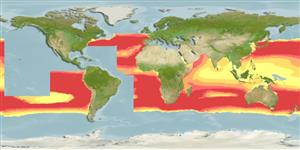>
Myctophiformes (Lanternfishes) >
Myctophidae (Lanternfishes) > Lampanyctinae
Etymology: Lampanyctus: Greek, lampas, -ados = torch + Greek, nykte = night (Ref. 45335).
Environment: milieu / climate zone / Tiefenbereich / distribution range
Ökologie
seewasser bathypelagisch; ozeanodrom (Ref. 51243); tiefenbereich 40 - 1052 m (Ref. 58018). Deep-water; 50°N - 56°S, 180°W - 180°E
Atlantic Ocean: north to about 40°N, with isolates to 50°N and from about 13°S to the subtropical convergence. Indian Ocean: two specimens recorded between 25° and 36°S. Pacific Ocean: Japan (Ref. 559), Australia (Ref. 7300), New Zealand (Ref. 5755) and Chile (Ref. 9068).
Length at first maturity / Size / Gewicht / Alter
Geschlechtsreife: Lm ?, range 8 - ? cm
Max length : 13.8 cm SL Männchen/unbestimmt; (Ref. 4479)
Rückenflossenstacheln (insgesamt) : 0; Rückenflossenweichstrahlen (insgesamt) : 13 - 16; Afterflossenstacheln: 0; Afterflossenweichstrahlen: 19 - 22.
Body shape (shape guide): elongated.
Oceanic and mesopelagic, found between 475-1,000 m during the day and between 40-325 m at night (Ref. 4479). Some small juveniles may be non-migratory (Ref. 4775).
Life cycle and mating behavior
Geschlechtsreife | Fortpflanzung | Ablaichen | Eier | Fecundity | Larven
Hulley, P.A., 1990. Myctophidae. p. 398-467. In J.C. Quero, J.C. Hureau, C. Karrer, A. Post and L. Saldanha (eds.) Check-list of the fishes of the eastern tropical Atlantic (CLOFETA). JNICT, Lisbon; SEI; Paris; and UNESCO, Paris. Vol. 1. (Ref. 4479)
IUCN Rote Liste Status (Ref. 130435: Version 2025-1)
Bedrohung für Menschen
Harmless
Nutzung durch Menschen
Tools
Zusatzinformationen
Download XML
Internet Quellen
Estimates based on models
Preferred temperature (Ref.
123201): 1.9 - 18.2, mean 11.9 °C (based on 388 cells).
Phylogenetic diversity index (Ref.
82804): PD
50 = 0.5000 [Uniqueness, from 0.5 = low to 2.0 = high].
Bayesian length-weight: a=0.00479 (0.00217 - 0.01054), b=3.16 (2.98 - 3.34), in cm total length, based on LWR estimates for this Genus-body shape (Ref.
93245).
Trophic level (Ref.
69278): 3.2 ±0.3 se; based on size and trophs of closest relatives
Widerstandsfähigkeit (Ref.
120179): mittel, Verdopplung der Population dauert 1,4 - 4,4 Jahre. (Preliminary K or Fecundity.).
Fishing Vulnerability (Ref.
59153): Low vulnerability (10 of 100).
🛈
